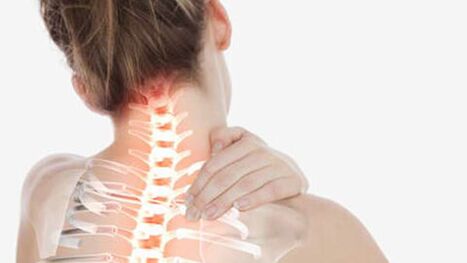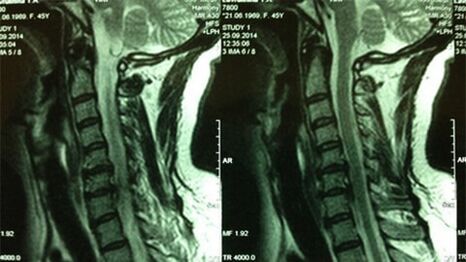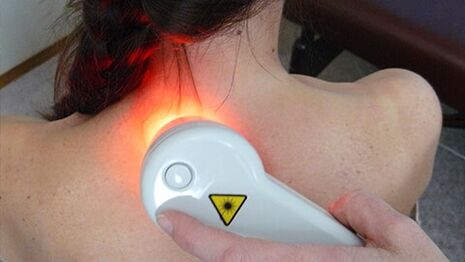
Cervical osteochondrosis is a progressive degenerative-destrophic process, which leads to exhaustion, deformity and destruction of the intervertebral discs of the cervical region.The loss of the cartilage that adopts the stroke causes pain as due to exposure of joint surfaces (spondillartrosis), and due to the refining of the nerve roots of the spinal cord.
In the absence of timely treatment, it is possible to overthrow the spine with the loss of its natural flexibility, the damaged blood supply to the brain, the deterioration of nerve conveyance in those parts of the body that innovate the cervical spine roots.
Pathology can develop both independently and as part of a general spine damage with the cover of the chest, lumbar and sacral parts.
General information
It is believed that cervical back osteochondrosis is more common than in other departments.In fact, this is not so - the dystrophic phenomena are evenly developed at all points of maximum load - in the area of the main curves of the spinal column (the lower the department is, the greater the load it carries).However, the symptoms of cervical osteochondrosis are more pronounced, so they look more frequent.This is due to the high mobility of the neck vertebrae, which at the same time hold the head, as well as the uniqueness of the rotational root exits of the spinal cord.
Exactly!According to statistics, the disease affects more than 60% of medium and elderly people.However, recently, a renovation of the pathological process has been observed - the pathology is found in young people and even adolescents.This is due to the overall computerization of the study and work, as well as a decrease in physical activity and a deterioration in food quality.
Given the age audience, 2 forms of cervical osteochondrosis can be distinguished - physiological and pathological.
Physiological processIt is associated with natural aging of the body when the symptoms of the disease are a consequence of the gradual wearing of the intervertebral discs.The process occurs under the influence of the endocrine system and is a consequence of menopause.The destruction of cartilage structures begins from the center of the intervertebral disc and is associated with a gradual replacement of the fibrosis cartilage tissue.The pathology is irreversible, however, it can be offset by special medicines.
Pathological processIt is accompanied by devastating abnormal changes in the body - immune, dystrophic, inflammatory, metabolic.First of all, subcutaneous tissue of salts appears in bone structures, nerve roots occur, atrophy or skeletal muscle hypertonitis occurs, which leads to blood circulation disorders.With timely diagnosis, the pathology is treated and ends with the complete restoration of the healthy function of organs and tissues.
Stages of cervical osteochondrosis and their symptoms
There are 4 main stages of the pathological process:
- The first stage-is expressed with little discomfort and muscle overload in the diseased region, cartilage discs lose their stability;
- The 2nd pain in the scene appears, especially with the head movements.The intervertebral discs are deformed, the fibrous ring begins to collapse, the distance between the vertebrae decreases;
- Phase 3-Practice intensifies and becomes continuous, movement becomes limited.Head heads can provoke periods of dizziness, nausea, a violation of blood supply to the brain leads to general hibernation, rapid fatigue, damaged concentration, cartilage tissue is thinner, vertebrae is closed, fibrous rings are completely destroyed with the appearance of intervertebral hernia;
- The 4th phase-the pain syndrome completely immobilizes the neck area, the brain's blood circulation is disturbed and requires constant drug support, the beads begin to grow together.
Cervical osteochondrosis: signs, symptoms of pathology
In the early stages, osteochondrosis is asymptomatic.As the disease develops, a special feature is the presence of painful or unpleasant sensations in the head, neck and chest, less often the upper limbs.
All possible symptoms can be provided on conditionally 4 types of syndromes: heart, vertebral, royal (irritable) and spinal artery syndrome (with circulatory disorders).
Vertebral syndrome:
- cramp on the neck when the heads turn/climb;
- As the disease progresses, the pain and difficulty of movement occur;
- Disordishes Morphological disorders of the structure in the body of vertebra and intervertebral space (visible on X -Ray).
Heart syndrome:
- shortness of breath, weakness;
- a feeling of incomplete breathing, lack of air;
- Spontaneous phenomena from the cardiovascular system-angina pectoris, cloth pain, burning;
Novice syndrome:
- numbness of tongue, shoulders, fingers, occipital region;
- difficulty swallowing;
- Unpleasant sensations in the area between shoulder blades;
- Headaches in Nape and Ball.
Vail artery syndrome:
- unreasonable jumps in blood pressure;
- dizziness, until loss of consciousness;
- noise in the ear, a feeling of cotton wool on the head;
- temporary one -sided blindness, "flies" to the eye;
- periodic nausea attacks, especially when they go;
- headaches - mainly in napes as well as migraines;
- drowsiness, decrease in performance, memory, attention focus, depression.
Attention!All of these syndromes should be combined with one another.The lack of symptoms of one of them may be a reason for differential diagnosis with other groups of diseases.
Causes of cervical osteochondrosis
The dostrophical phenomena in the cervical spine are associated with the vertical location of the skeleton and the specific distribution of static and dynamic loads, which largely depend on the predominant position and the degree of development of the skeletal muscles.
The main reasons:
- Lack of movement - what does not develop - degrades: muscles are weakening, tissues are destroyed;
- Incorrect static positions - muscle clips lead to blood circulation disorders with subsequent tissue dystrophy;
- Lack of food or an unbalanced diet - the body should take everything necessary for the construction and renewal of bone structures and skeletal cartilage, maintaining muscle tone;
- Obesity, overweight, Weight Wearing - the load on the skeleton structure increases;
- constant nerve tension and nerve stress;
- Cervical region hypothermia - "caught", "swollen" - provokes hidden inflammatory processes;
- The presence of autoimmune diseases with the inclusion of cartilage tissue leads to its premature destruction;
- Endocrine pathologies are confused by mineral metabolism, reduce the solubility of calcium, silicon, phosphorus and other elements of bone-chryshot tissue;
- damage to the cervical region;
- Congenital abnormalities of the spine muscles and adjacent.
Troubleshooting

The diagnosis of "cervical vertebrate osteochondrosis" is composed of low specificity of symptoms and a wide variety of their manifestations.In the examination process, a neurologist, surgeon, orthopedist, cardiologist will be required.
A physical examination is performed by a physician with a patient study.The main diagnostic load lies in the instrumental and laboratory search methods.
Instrumental diagnostics:
- X -Ray of the cervical department;In the initial phase of the process, the MRI of the cervical department will be more informative - will provide high -quality solid and soft tissue visualization - will indicate the state of the intervertebral discs, the presence of osteophytes, deformities, damage to the nerve roots and blood vessels;will evaluate the condition of ligaments, muscles, bone tissue;
- Ultrasound shows the dynamic state of soft tissue;
- Dopplerography of the neck vessels will help evaluate hemodynamics and the degree of damage to the blood vessels (in particular, the condition of the spinal artery);
- Contrast myelography - will help with the suspicion of breaching nerve processes;
- ECG and heart echocardiography are used for differential diagnosis of cardiac syndrome with cardiovascular disease.
How to treat cervical osteochondrosis
The complex of medical measures is formed taking into account the stage of the disease (acute, chronic), the degree of damage and the causes of the development of pathology.Use conservative treatment, surgical intervention, mixed access.
Conservative effect
Is a gradual restoration or compensation for damage to the background of symptomatic treatment.Includes medication therapy, physiotherapy, exercise therapy and massage methods.
Treatment:
- Painkillers - mainly gel and ointments of local influence;In severe cases - common sedatives in the form of tablets;
- anti -inflammatory drugs - NSAIDs, as well as corticosteroids (short course if necessary);
- Medicines for improving microcirulation and blood circulation in general;
- Chondroprotectors - tools for protecting and restoring cartilage clothes;
- Musorelaxants - to eliminate muscle clips and spasms;
- Vitamin and microelen complexes are needed for feeding and supporting fabrics by building elements.
While acute symptoms are weakened, the methods of physiotherapy, exercise therapy and self -massage are related.
TherapeuticImproves cartilage and bone tissue nutrition by restoring blood supply to the damaged area.To avoid complications, it is recommended to use the method of isometric movements, when instead of real curves and slope of the head that can damage, they use their imitation.
Attention!All actions should only be performed after diagnosing and consulting a physician.
The technique allows you to develop and strengthen the atrophied short neck muscles and stabilize the cervical spine position.Sequence of Basic Exercises:
- The palm of the right hand is reduced to the lateral surface of the head press your palm in your head within 10 seconds, while strain the head and neck muscles for resistance-root should remain stationary.
- Lower your hand, relax your head and neck muscles as much as possible for 20 seconds.
- Repeat the drill with the left hand.
- Take both hands with your palms on the forehead-pip to the forehead for 10 seconds, as if you try to reject your head back while strain the neck muscles to resist the movement.The head should remain stationary.
- Reduce your hands, relaxing the muscles similarly to the previous exercise.
- Place both palms in the area above the back of the head.By analogy, perform a pressing load on the neck muscles, trying to glue your head forward - it should still be without movement.
- Lower your hands, relax the neck and scalp muscles.Repeat the group of exercises 4-10 times.
After strengthening the short neck muscles, you can start performing dynamic exercises.
Exactly!As a methodology for restoring the mobility of the cervical region, swimming and water gymnastics have proven themselves well.
Self -massageIt allows you to reduce the intensity of local reactions and remove muscle clips during static work.Rules for execution:
- Exposure area - the back of the head, back and lateral surfaces of the neck;
- perform the procedure in a sitting position;
- Movements must be carried out in the direction of the spine;
- Use only fingertips;
- Avoid pressure in inflamed areas;
- Perform movements smoothly - sharp pressure can damage.

PhysiotherapyCharacteristic for hospital treatment and rehabilitation of sanatorium resort.Well prove themselves:
- Electrophoresis - listens to the area, improves microcirculation, is used for deeper penetration of local medicines;
- magnetotherapy;
- amplulid;
- UHF.
Surgical intervention is indicated by complex extraction, spinal cord violations and unconscious pain syndromes.
Than osteochondrosis of the cervical is dangerous
The neck area concentrates dense braids of the main blood vessels, nerve processes and dynamic bone skeleton structures.In the absence of treatment, serious pathological changes can be observed:
- Weakening of the fibrous ring provokes displacement and subluxation in the area of the most removable vertebrae;
- The presence of osteophytes and muscle spasm leads to violations of nerve roots and blood vessels with the formation of compression syndromes;
- The destruction of the cartilage discs and the approach of the vertebrae leads to intervertebral hernia with nerve tissue disorders.
Each phenomenon follows a significant negative reaction from the whole organism.
Possible complications and consequences
The list of the most common complications of cervical osteochondrosis may be included:
- vegetovascular dystonia;
- hypertension;
- the hunger of the brain's oxygen and its structures;
- eye retinal dyin with visual impairment;
- Failure of thyroid failure;
- Disruption of the functions of the esophagus and trachea - difficulty in swallowing and breathing cramps;
- Unconscious pain syndrome in the head, neck, chest, upper extremities;
- convulsions and numbness of the face, hands;
- Disordishes of the hypothalamic-pituitary system that attracts a failure to the entire hormonal activity of the body.
Preventive
The most effective treatment is the prevention of the disease.Prevention will help you in this.It is enough to follow some basic recommendations:
- Adjust your behavior
- Create a suitable job;
- During the sedentary work, take a break in "physical education";
- Include in your diet -rich diet foods, magnesium, phosphorus, silicon - fish, nuts, seeds, legumes, dairy products, fresh vegetables, fruits;Limit salt, sweet, flour and sharp dishes;
- For sleep and rest, use orthopedic mattresses and pillows;
- Take care of an impartial sport - it is best to give preference to swimming.
Even if you are unable to consider all the requirements, moderate physical exercise, proper nutrition and attentive attitude towards your behavior can significantly reduce the risk of pathology.



































